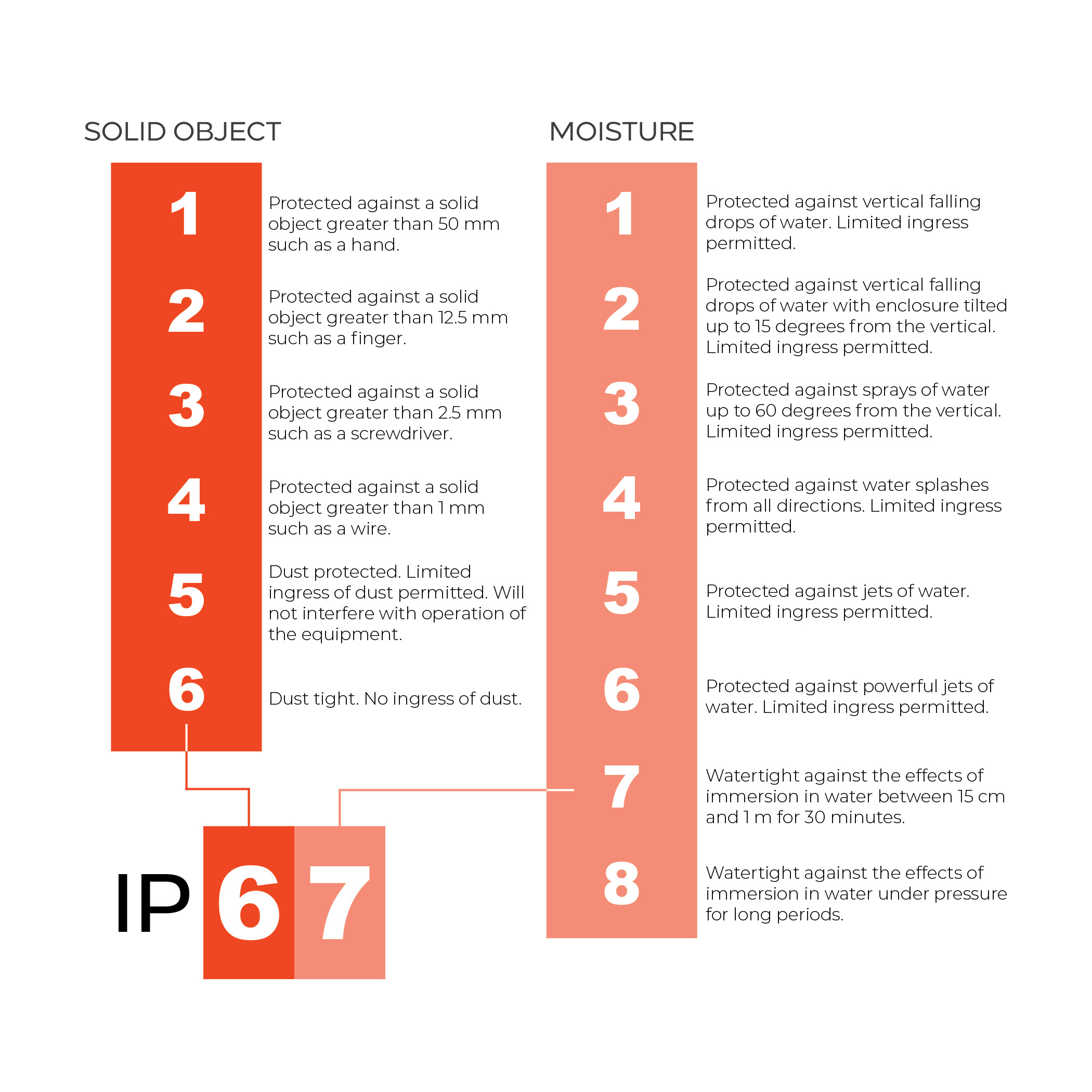RFID & IP Ratings - What You Need To Know
IP Rating, or Ingress Protection Rating, is an international grading system for enclosures of mechanical or electronic equipment. IP rating measures resistance to ingress from foreign bodies like dust and dirt, and resistance to moisture ingress like steam and water. Because these are two different resistance measures, an IP rating usually consists of two digits.
The first digit is between 0-6, and indicates the degree of protection from solid objects like dust, dirt, or particulates, with 0 being the least protected and 6 being the most protected. Below is a chart depicting the level of coverage associated with the first and second digits.

The second digit is between 0-9 and indicates the degree of protection from moisture, with 0 being the least protected and 9 being the most protected. Moisture ingress is typically measured by water spray, splashing, pressured spray, and then finally by water submersion. At levels between 7 and 9, immersion in water is tested in general, as well as submersion at specific depths, pressures, and lengths of time. For example, the iPhone 11 Pro is rated IP 68, with a maximum depth of 4 meters up to 30 minutes.
Below is information about how IP Rating affects each part of an RFID system.
IP Ratings - RFID Readers & Printers
RFID Readers and Printers are enclosed electronic devices which means that most are IP Rated. An IP Rating for an RFID Reader or Printer is good to know before purchasing, especially if it will be used in an outdoor environment. For indoor applications in a business or retail environment, consulting the IP Rating typically isn’t necessary because it is a climate controlled, clean workspace.
For application environments like warehouses, manufacturing facilities, or any facilities that are open to or partially open to the outdoors, a reader or printer’s IP rating must be consulted. In these environments, it is generally recommended to purchase a device that is rated above IP 60 so that the product is completely protected from dust and other particles. The level of water protection (the second digit, 0-9) can then be decided based on the specific application environment.
Most RFID Readers typically range between IP 50 and IP 55 which are recommended for indoor use only; however, a smaller range of products are rated IP 60 and above intended specifically for warehouse, industrial, and outdoor environments.
In handheld reader applications, it is usually recommended to choose a device with a high IP rating unless the application environment is completely indoors, climate-controlled, and kept clean. This is because handheld readers can be susceptible to a large range of particles, dust, high temperatures, and moisture because they move often and are not fixed in one place.
If a Fixed RFID Reader is ideal for a specific application but is not rated high enough for the application environment, an enclosure can be used. RFID Reader Enclosures are ideal for protecting readers from dust, dirt, other particles, water, high temperatures, and direct sunlight. RFID Reader Enclosures can also store small GPIO devices or computing devices that need to be further protected from water and debris.
RFID Printers typically are manufactured and labeled for either an industrial or desktop application, which can make the purchasing decision simpler.
IP Ratings - RFID Antennas
IP Ratings for RFID Antennas are mainly used to determine whether the antenna should be used strictly indoors or in an environment that is non-climate controlled indoors, partially outdoors, or fully outdoors.
Unlike RFID Fixed Readers, RFID Antennas typically do not have an option to be placed in an enclosure if mounted outdoors with a low IP rating. Luckily, most manufacturers offer an assortment of indoor and outdoor antennas to choose from. Some manufacturers offer two extremely similar antennas, with the only difference being that one has a higher IP rating for use outdoors.
For example, Times-7’s A5531 Ground RFID Antenna, rated IP 53, is essentially the indoor version of Times-7’s A5530 Ground RFID Antenna, rated IP 66.
If a system’s RFID antenna needs to be mounted in an environment that is non-climate controlled, partially outdoors, or fully outdoors - it is always recommended to choose an RFID Antenna rated above IP 65.
IP Ratings - RFID Tags
Typical, low-cost RFID wet inlays and paper labels are not IP rated because they do not have a proper enclosure. Wet inlays and labels are not suggested for rugged applications or in environments where they could be subjected to water.
Rugged RFID tags that are enclosed in a plastic or metal enclosure are typically IP rated relatively high because the tag can be fully encased with no holes or gaps for connectors. If an application is need of a tag that can withstand dust and water immersion, it is recommended to purchase a tag that is rated IP 67 or higher.
RFID tags with an enclosure are usually additionally tested for other environmental concerns like high/low temperatures, impacts, high pressure, and high levels of vibration. If a tag will be permanently mounted in an outside environment it is important to take in consideration these other environmental concerns, and sun exposure, as well as the IP rating in order to select the ideal tag.
NOTE: Because antenna cables are not completely enclosed, they are not IP rated. IP rating is similar to, but should not be confused with, Insulation Rating, also called LMR. Learn more here.
Conclusion
For more information on IP Ratings or recommended hardware and tag testing, comment below or contact us!
To learn more about RFID and the environment, check out the links below!
